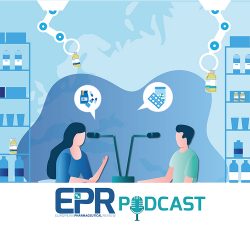
European Pharmaceutical Review podcast
EPR Podcast Episode 8 – Oral biologic drug delivery with Giovanni Traverso, MIT

In this episode, we discuss one of drug delivery’s greatest challenges: how to orally administer biological therapies, such as antibodies and hormones. To address such an important topic, we are joined by Giovanni Traverso, Assistant Professor in the Department of Mechanical Engineering at Massachusetts Institute of Technology (MIT), and a gastroenterologist at Brigham and Women’s Hospital (BWH), Harvard Medical School. His research focuses on the development of next generation drug delivery systems and biomedical devices to support new modes of drug administration.
Biologic therapies are growing in popularity, accounting for 13 of the 53 new drugs the US Food and Drug Administration (FDA) approved in 2020. Though promising, these therapeutics present several drug delivery challenges, including that their composition makes them liable to damage in the gastrointestinal (GI) tract, requiring them to be delivered intravenously or subcutaneously. While manageable for infrequent treatments, for those who must be injected regularly, such as diabetes patients, being able to simply swallow a pill may seem much more desirable.

Giovanni Traverso, Assistant Professor, Department of Mechanical Engineering, MIT, and gastroenterologist at Brigham and Women’s Hospital (BWH), Harvard Medical School
Giovanni explained that, when discussing the delivery of biologic drugs, he splits the mechanisms into two broad categories: non-physical and physical modes of delivery. “From a non-physical perspective, what I mean is molecules or additives that enhance transport across the mucosa/protective layer in the GI tract… for example, there are a couple of smaller peptides or proteins that actually do exist in an oral formulation and those apply either an additive that transiently enhances transport or the drug has somehow been modified to stabilise it to facilitate its transport,” he explained. These systems are limited by the size of the molecule with smaller peptides, proteins and even insulin able to be delivered in this fashion, but not monoclonal antibodies and other larger molecules.
Physical techniques, he described as those that involve some kind of intervention such as a medical device, eg, a hypodermic needle for injections, or ultrasound at certain frequencies to propel drugs into tissue. “On the physical side we have actually been able to deliver a very broad set of molecules, including monoclonal antibodies,” stated Giovanni.
We went on to discuss his team’s recent work on the development of gastric autoinjectors and how, during the process, they broke it up into three challenges: a. ensuring the sharp needle is always in contact with the desired tissue, b. how to autonomously trigger the drug delivery event/injection, and c. how to fit enough drug within a blueberry-sized device, a safe capsule size for oral administration. They addressed orientation challenges in a paper published two years ago and reviewed materials that could hold energy from a compressed spring, with brittle fracture mechanics, that could sense a humid environment. They eventually designed sugar cylinders that had these elements and could be adjusted to control the rate of dissolution and drug release through the needle.
To overcome the challenge of size and ensure they could deliver enough drug, they developed solid formulations of biologic drugs, such as insulin. However, a fluid dose was more desirable, and in a recent paper published in Nature Biotechnology they displayed the development of a self-orientating gastric autoinjector system able to release a liquid. The research was done in collaboration with Novo Nordisk and demonstrated that the system could deliver insulin, a GLP-1 receptor analogue, adrenaline and adalimumab, a monoclonal antibody.
Then we explore other issues surrounding the oral delivery of biologics, including that future developments into miniaturising these device systems may be necessary to ensure compliance and that not all drugs would be suitable for this kind of administration. “Which drug is the right drug to go into these systems? It is not that you convert every injectable – and there are drugs that I think are more amenable to being administered orally,” explained Giovanni, adding that for instance those drugs with a narrow therapeutic window may not be the best option due to variability in absorption caused by inherent differences in peoples’ GI tracts.
To learn about other drug delivery systems, including those Giovanni has helped develop to allow once-a-month dosing of contraceptives and HIV medications, and how critical biomedical devices are likely to be in overcoming various drug delivery challenges, listen to the episode!
Please join the conversation and leave your thoughts in the comments – we love hearing your feedback – and look out for our next episode coming soon!
Resources
To learn more about gastric autoinjectors, read the paper published in Nature Biotechnology: https://doi.org/10.1038/s41587-021-01024-0
For more information on gastrointestinal-based drug delivery challenges: https://doi.org/10.1038/s41575-021-00539-w
The papers on once-monthly dosing drug delivery systems for contraceptives and HIV medications can be found at: https://www.science.org/doi/10.1126/scitranslmed.aay2602 and https://doi.org/10.1038/s41467-017-02294-6
The paper describing the team’s oral drug delivery screening tissue culture system was published in Nature Biomedical Engineering: https://doi.org/10.1038/s41551-020-0545-6
The post <em>EPR</em> Podcast Episode 8 – Oral biologic drug delivery with Giovanni Traverso, MIT appeared first on European Pharmaceutical Review.